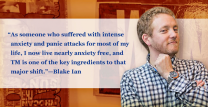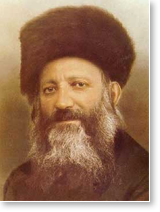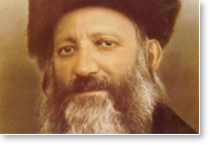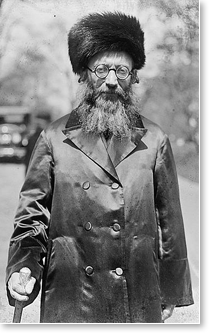Rabbi Abraham Isaac Kook
1865–1935 • LATVIA AND ISRAEL
Abraham Isaac Kook was one of the greatest figures in 20th century Judaism.
Considered a prodigy as a child, Kook (pronounced cook) became a rabbi at the age of 23, serving first in small communities in Latvia and Lithuania. In 1904, when he was 39, he moved to Palestine (prior to the formation of Israel) and established a Jewish academy (yeshiva) in the seaport town of Jaffa.
During World War I, while visiting Germany, he was taken prisoner as an alien but escaped to England. There he became rabbi of a congregation in London, where he helped win popular support for establishing a home for the Jewish people in Palestine. In 1921 he was elected Palestine’s first chief rabbi, a position he held the rest of his life.
He was a renowned Torah scholar, an expert in Jewish law, and a student of the Kabbalah. He was esteemed for his intellectual prowess and admired by the common people, whom he loved in return. He was noted not only for his philosophical writings but for his poetry.
He combined a dedication to traditional Jewish values with an openness to new ideas. He had an expansive personality that embraced and sought to unify divergent political and religious viewpoints. He did not belong to any political party; he insisted that all Jews needed to work together.
Drawing from the Kabbalah, Rabbi Kook valued its concept of Ein Sof, the underlying, infinite, divine source of everything in the universe. In his philosophy of “repentance,” human separation from God results from our losing our connection with this divine source, which lies within. As he wrote:
The greater you are, the more you need to search for your self. Your deep soul hides itself from consciousness. So you need to increase aloneness, elevation of thinking, penetration of thought, liberation of mind — until finally your soul reveals itself to you, spangling a few sparkles of her lights.
Then you find bliss, transcending all humiliations or anything that happens, by attaining equanimity, by becoming one with everything that happens, by reducing yourself so extremely that you nullify your individual, imaginary form, that you nullify existence in the depth of your self. “What are we?” Then you know every spark of truth, every bolt of integrity flashing anywhere.
Then you gather everything, without hatred, jealousy, or rivalry. The light of peace and a fierce boldness manifest in you. The desire to act and work, the passion to create and to restore yourself, the yearning for silence and for the inner shout of joy — these all band together in your spirit, and you become holy.1
Rabbi Kook repeatedly emphasizes the value of reconnecting with what he calls the “deep soul,” which is normally hidden from us. He describes the “deep soul” as a realm of bliss, equanimity, peace, truth, and liberation. It lies beyond all activity, even beyond our sense of individual self. When we experience it, he says, we discover who we really are — and when we emerge, our thoughts and actions are bold and joyful.
This is the experience that the Transcendental Meditation technique leads us to twice each day. With this simple, natural, effortless technique, the waves of mental activity settle down like waves settling on an ocean. Then we experience consciousness in its pure state, an infinite reservoir of creativity and intelligence and bliss. At the same time, the body settles into state of deep physical rest, dissolving deep-rooted stress and fatigue. Brain functioning becomes highly integrated and coherent.
Simple and effortless
Rabbi Kook emphasizes that this ability to transcend is the most important skill we can have — and it should be easy:
The most significant talent is the ability to penetrate to the depths of our own being. But to effect this penetration it is important to know that it is an easy endeavor, that labor and exertion only impairs this august domain, that it is necessary to heed the claim for the delight of inner tranquility. Thus will be enhanced the substantive significance in the fruits of creation, and the sparks of holy light will begin to flash on all life and its spiritual concerns. . . .
And eternal truths will be released to us from the fountain of life, the source of the soul, which knows no falsehood or deceptive speech. It is hewn from the torch of truth. What flows from its light is only truth and justice which will abide forever.2
Making any effort to experience “the depths of our own being,” Rabbi Kook observes, will be counterproductive. The experience should come naturally, he says, because this field of inner tranquility is a source of delight.
The Transcendental Meditation technique is founded on this exact principle. Maharishi points out that because the innermost depth of the mind is an ocean of creativity, intelligence, and bliss, the mind will be spontaneously be drawn to it because it is inherently more charming. We simply need to create the proper initial conditions. This is what the TM technique does. Without involving any effort, it creates the initial conditions for the mind to dive within. The rest is automatic.
Over the past 45 years, an enormous body of scientific research has documented the benefits of twice-daily transcending through the Transcendental Meditation technique. Stress is dissolved with exceptional efficiency. Brain functioning becomes increasingly integrated. Intelligence and creativity increase (a remarkable finding, because growth of intelligence normally levels off in the mid-teens). The personality develops in a balanced way. Anxiety falls away. Health improves, particularly cardiovascular health. Personal relationships improve. Bodies of research have shown the immense benefit of the Transcendental Meditation technique in schools, workplaces, and prisons, as well as addressing such challenging problems as post-traumatic stress disorder and substance abuse.
Benefits for the whole world
For Rabbi Kook, the experience of transcending benefits not only the individual but the entire world.
It turns out that the unity achieved in our souls serves to unite the world as a whole. And all those noble effects of the riches of the soul which everyone who is wise of heart, of a sensitive and holy spirit, can feel within himself through his own ascent because of the manifestation of the mystical discovery of inner unity — these spread and release light and vitality and become a source of blessing and an ornament of peace to the world and its fullness.3
The unity we experience within us in the state of transcendence, Rabbi Kook observes, radiates outward and brings nourishment and peace to those around us.
This is because pure consciousness is identical with what modern quantum physics calls the unified field — the field of intelligence underlying all the diversity in the universe. Every time we experience it during Transcendental Meditation practice, we enliven it. And because this field is all pervading, when we enliven it, we enliven it for everyone and everything.
Rabbi Kook anticipates the scientific research on what scientists call the Maharishi Effect — the finding that even a small portion of a population practicing the Transcendental Meditation technique creates an effect of orderliness for the whole population.
A number of studies have found, for example, that when 1% of a city’s population has learned the Transcendental Meditation technique, crime rates and accident rates goes down for the whole city, in comparison with matched control cities that have not reached the 1% threshold. These findings indicate the stress is being reduced and coherence quality of life is increasing for the entire population. (For a group of articles on this topic, click here.)
Rabbi Abraham Isaac Kook was a powerful leader, a profound thinker, a force for progress and peace and unity. He possessed a personality that appealed to a wide diversity of people. He recognized where his strength and vitality came from — through connecting with the “deep soul” within, the wellspring of bliss, peace, and freedom. Through his writings he repeatedly urged people to find this interior treasure for themselves.
Now, thanks to Maharishi’s life work, we have a simple, effortless technique by which everyone can do this, twice each day.
REFERENCES
1. Quoted in The Essential Kabbalah: The Heart of Jewish Mysticism, ed. Daniel C. Matt (Edison, New Jersey: Castle Books, 1997), 124.
2. The Essential Writings of Abraham Isaac Kook, ed. and trans. Ben Zion Bokser (Amity, New York: Amity Books), 1988), 153.
3. Essential Writings of Abraham Isaac Kook, 160.
____________________________________
Related Blogs:
Orthodox Rabbi speaks on his 9-year TM practice
https://www.tm.org/blog/people/rabbi-transcendental-meditation/
How I Learned TM—by Rabbi Alan Green
https://www.tm.org/blog/meditation/how-i-learned-tm-rabbi-alan-green








